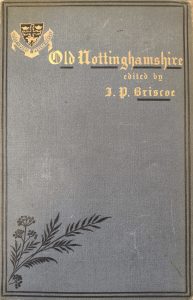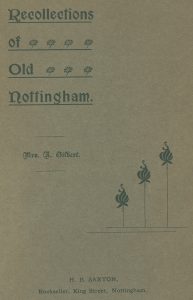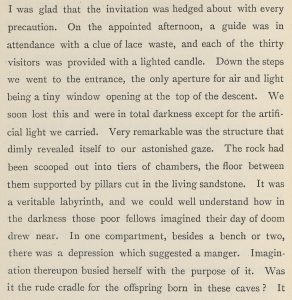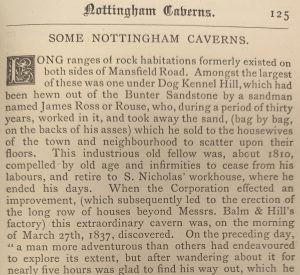February 6, 2025, by Chloe
Into the Labyrinth
The story of the rediscovery and exploration of Nottingham’s caves has often been driven not only by determined study, but also by simple curiosity and even happenstance. This was certainly the case in 1837, when, in the course of the construction of a row of houses along Mansfield Road, the entrance to a mysterious labyrinth was accidentally uncovered…

Old Nottinghamshire edited by John Potter Briscoe; c.1881-1884. University of Nottingham Not 1.D14 BRI
The tale was relayed by J. Potter Briscoe nearly half a century later in an article entitled ‘Some Nottingham Caverns’ and later published in the compendium ‘Old Nottinghamshire’. In his telling, one particularly courageous soul had entered the system, only to emerge nearly five hours later, saying that he had been unable to find his way out again.
Undeterred, a pair of men ventured below with lanterns the next day, feeling their way forward for a couple of hours until they happened across a fellow wanderer who led them to ‘a chamber in which they observed five men sitting around a light, playing at cards’. After a while, the same man offered to lead them back the way they came, but, while on route, they were set upon by ‘a gang of ruffians’ who beat one up and robbed him while the other fled the scene, hiding nearby.
Far from causing a public outcry, the incident seems to have created something of a trend for exploring the site: in the following days it was ‘crowded to excess’. Even years later, it seems they were still the object of some interest. Later in the century, Briscoe himself and the architect Samuel Dutton Walker were led into the Peel Street caves by a guide, accompanied by a young girl who spun out a line of lace behind them so that they could retrace their steps. The author was somewhat disappointed not to encounter any signs of revelry except a few empty bottles, but intriguingly, a tomb sculpture in the form of a person at rest, allegedly the creation of the artist Andrew MacCallum.

Front cover of ‘Recollections of Old Nottingham’ by Mrs A. Gilbert; c.1901. University of Nottingham EMC Not 3 D28 GIL
And Briscoe certainly wasn’t alone in being undeterred by the danger. Writing at the turn of the century, Ann Gilbert, author of Recollections of Old Nottingham, described how she had been inspired to make her own exploration of the same cave system after hearing that a pair of curious workmen had entered, only to lose their way and remain trapped within overnight until a rescue party retrieved them the following morning. To be fair, her party took several precautions: they were a crowd of thirty, each with a candle, and led by a guide who – again – traipsed a long string of lace behind them. As she wandered, she imagined the caverns as ancient homes: a bench here; a cradle there. Oddly, she was aware of the theory of the network’s origin as a sand mine but dismissed it of hand in the face of their grand scale. Briscoe, writing several decades earlier, provides more detail, claiming that its excavation was the secret project of one man, who dug it out over a lifetime, living off the sand sales until old age forced him to cease digging.

‘Recollections of Old Nottingham’ by Mrs A. Gilbert, page 8; c.1901. University of Nottingham EMC Not 3 D28 GIL
The Peel Street caves have since been proven conclusively to have been dug as sand mines, though certainly not the work of one person! If you’d like to find out more about Nottingham’s many cave explorers, why not check out ‘Tales from the Caves’, which is running in the Weston Gallery at Lakeside Arts, Nottingham until 9 March 2025? Learn more on our website!
No comments yet, fill out a comment to be the first


Leave a Reply